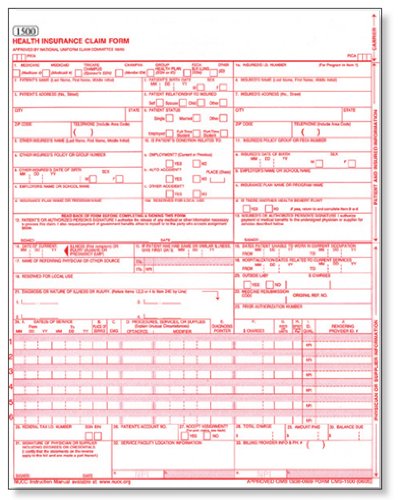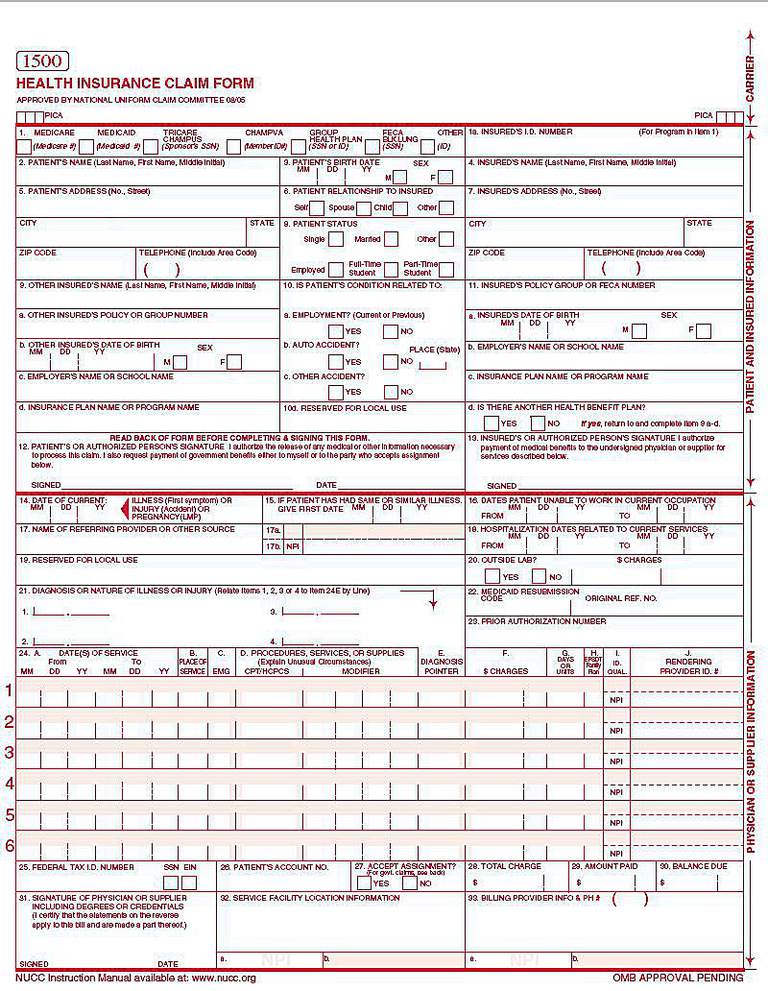 Photo by Pixabay
Photo by PixabayOriginally Posted On: What Is HCFA in Medical Billing? | Medical Billing Service Review
What Is HCFA in Medical Billing?
 There are specific protocols when billing with insurance companies. One of those protocols is filling out form HCFA. Here’s what to know about this form.
There are specific protocols when billing with insurance companies. One of those protocols is filling out form HCFA. Here’s what to know about this form.
The Health Care Finance Administration (HCFA) form is a claim form used in settlement of government insurance programs such as Medicare and Medicaid to medical providers. Developed by The Center of Medicaid and Medicare (CMS) but was adopted as a standard form by all Insurance plans.
Clinical practitioners and physicians use the HCFA to submit claims for professional services. Federal regulations require all healthcare providers to use the HCFA or UB-04 form for filing claims.
Keep on reading to learn more!
The HCFA/CMS-1500This form is universal, and all healthcare providers use them to bill health insurance providers. Both Medicaid and Medicare, part B services, are billed using this form. The National Uniform Claim Committee (NUCC) maintains this form.
The HCFA contains all the essential info required to submit a precise claim. In this form, the healthcare provider should include the following;
- Patient’s demographic information
- Patient’s insurance information
- Medical Codes
- Dates of service
The information filed in this form should be accurate and factual. To avoid disputes, healthcare providers should be truthful when filling the form. In case the insurance detects irregularities, they may fail to honor the claims.
There is a specific box that applies to each health provider. The payer might provide different info on how to fill some boxes. The medical coder and biller must be familiar with some specific payer requirements.
How Does the HCFA Form Work?Firstly, the healthcare provider treats a patient and then sends the bill of services to the designated payer. Usually, the designated payer is the insurance provider. The insurance provider evaluates the claims and determines the services to reimburse.
When the healthcare providers offer the services to the patients, they record the services using the appropriate medical codes. CPT codes apply for various treatments while ICD codes apply for diagnosis. These codes provide a summary of services offered by the provider.
Also, the patient’s insurance information and demographic data are added to the bill. It is after this when the claims get processed.
Who Can Fill Insurance Claims Using the HCFA?Individual healthcare physicians and not institutions can only fill this form. Below are some of the people who can fill the form;
- Clinical psychologists
- Nurse practitioners
- Physician practitioners
- Ambulance services
- Diagnostic laboratory services
- Nurse Midwives
- Physician assistants
- Certified nurse anesthetics
- Clinical social workers
Only non-institutional healthcare providers should submit insurance claims using the HCFA form. Institutional providers should submit applications using the UB-04 form.
Filling the Claims For the insurance claims to be met, some set industry standard and protocols have to be met. The medical billers use software to record patient data, prepare the claims, and submit to the appropriate insurance provider. However, there is no universal software that the biller must use.
For the insurance claims to be met, some set industry standard and protocols have to be met. The medical billers use software to record patient data, prepare the claims, and submit to the appropriate insurance provider. However, there is no universal software that the biller must use.
All insurance billing software uses a set of standards set by the HIPAA and the Code Set Rule (TCS). The insurance claims can be filled manually on paper or electronically. Many healthcare providers prefer the electronic system to the manual one.
The electronic system is faster and more accurate compared to the manual one. However, the medical provider should be well versed with both methods.
Rules for Filling the HCFA FormThe HCFA form should be filled according to the provisions of the law. The claims can be rejected if the form is not correctly filled. You can avoid rejection of the claims by doing the following;
- Fill all data accurately and precisely in the specific fields
- Use the address for the service facility
- Include NPI information where required
- Use the correct procedure and diagnosis codes
- Enter the patient’s insurance information
The insurance providers need accurate data.
How to Fill the HCFA FormHow the biller fills the HCFA form determines whether or not the insurance provider will offer compensation. The HCFA has 33 boxes that you must fill. Below is a detailed guide on how to fill each detail
1. Type of PayerIn this part, you mark the type of health insurance coverage, i.e. Medicare or Medicaid. Also, enter the patients’ insurance number.
2. Patient’s Name and GenderEnter the full patient’s name, as shown in the Medicare Card. This section allows entry of up to 28 characters.
3. BirthdateIn this box, the medical provider should include the patient’s date of birth and gender. Use the 6-digit or 8-digit format.
4. Name of the InsuredEnter the name of the insured if not the patient. It can be spouse employment or any other primary. Leave blank if the patient is the one insured.
5. Physical AddressEnter the patient’s address and zip code. The first line is for street address, city, and state on the second line and zip code on the third line.
6. Patient’s relation to the insuredMark one box showing the relationship of the insured, whether spouse, child, etc. Mark the corresponding on the form.
7. Insured’s addressEnter the insured’s city, state, zip code, phone number, and address. If unknown, leave the physical address details blank. Use employer’s address for worker’s compensation.
8. Patient StatusFill the general status of the patient. Status includes; worker, student, employed, and marital status.
9. Other Insured’s DetailsInclude there exists additional health coverage for the insured, add in this column. That consists of the extra health coverage details, personal details, employers detail, school, etc.
10. Reserved for Local UseThis part is preserved for Medicaid information. Enter the patient’s Medicaid number if available.
11. FECA Number/Insured’s Policy GroupInput the insured’s group number or policy as written in the ID card. This proves that the physician made an effort of determining whether it’s primary or secondary Medicare.
12. Patient’s SignatureThe patient should sign on the file. If the patient is debilitated, then an authorized representative should sign or enter a 6-digit/8-digit alphanumeric date. If a representative signs, the reasons should be indicated on the line followed by the representative’s relationship and personal details.
13. Insured’s SignatureIf the Medigap info is included in section 9, the insured is supposed to authorize the payment by signing in this section. A signature on file is the most appropriate for this section.
14. Date of IllnessWhen did the patient get ill? The biller should enter the exact date of illness, pregnancy, or illness.
15. Other DatesFill this information if the box 10b and 10c are checked. Use a 6-digit or 8-digit to enter the date of a related patient’s condition.
16. Date of IncapacitationIn this section, enter the date in which the patient was unable to work in the current occupation. This section applies if the patient is unemployed but unable to work.
17. Name of Referring PhysicianThis section applies if another physician referred the patient. Enter the full names, ID number, and NPI number of the referrer.
18. Hospitalization DatesIf the patient was hospitalized, enter the date of hospitalization. You could leave blank if there was no hospitalization needed.
19. Additional Claim InformationThe biller should enter the date when the physician’s NPI saw the patient. The payer assigns the identifier to identify the provider uniquely.
20. Outside Lab ChargesThe biller should fill this section when billing for diagnostic tests. Mark ‘yes’ if another party other than the provider is offering the service.
21. Patient’s Diagnosis ConditionAll health providers, except ambulance services, should enter a patient’s diagnosis specificity using special codes. The codes should be accurate and correct.
22. Medicare Resubmission CodeEnter the original reference number in case of resubmitted claims. This section does not apply for original claim submission. Leave this section blank for Medicare
23. Prior Authorization NumberIf the medical procedures require QIO approval, enter the QIO prior authorization number. If an investigational device, enter the 7-digit IDE number. For ambulance services, provide the 5-digit zip code of pickup point.
24. Details of ServiceIn this section, the biller should include the following;
- Dates of service
- Place of service
- Services or procedures
- Charge amount
- Diagnosis Pointer
- Units/days of service
The above sections do not apply for pneumococcal or influenza vaccine.
25. Federal Tax ID NumberEnter the details of the provider of service (EIN or SSN). This is the unique number used for reporting taxes.
26. Patient’s Account NumberEnter the patient’s number provided by the service provider. This part is not mandatory as it helps the provider to identify the patient.
27. Accept AssignmentTick the appropriate box to agree to the assignment benefits. Assignment benefits include the following;
- Supplier/physician services
- Laboratory services
- Surgical services
- Ambulance services
Be sure to select options that only apply to your case.
28. Total Charge of servicesThe biller should enter the charge of services. Insurance providers require realistic and unexaggerated charges.
29. Amount PaidThe biller should enter the amount paid for the covered services. This does not include discounts.
30. Balance DueLeave this section plank. Medicare does not need you to fill this section.
31. Signature of the Healthcare ProviderThe physician or non-physician offering the service should enter a signature file. The current dates should follow the provider’s signature.
32. Facility Zip CodeEnter the location of the physician’s facility zip code. This applies for services payable under the provider’s fee schedule.
33. Billing Provider NPI and TaxonomyThe biller should enter the facility’s NPI. In this section, the biller should enter their name, address, zip code, and phone number. This is the final section and identifies that the provider is requesting payment for the rendered services.
The Bottom LineAs evident in the above, filling the HCFA form is not an easy task. Inexperienced health care providers should ask for professional medical billing help to avoid messing up and missing out on claims.
If you’re looking for medical billing services, be sure to get quotes for a better comparison.












